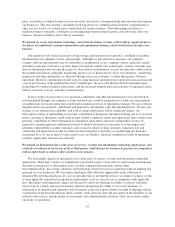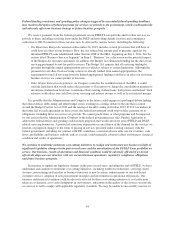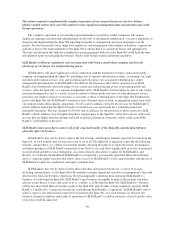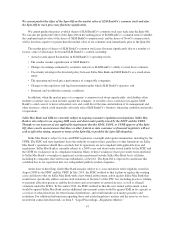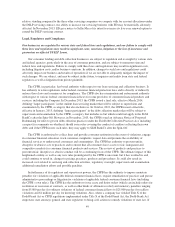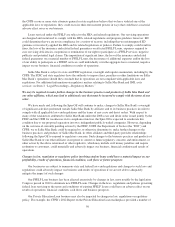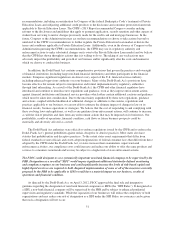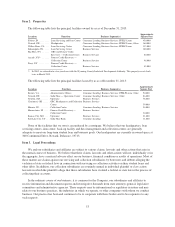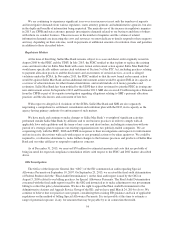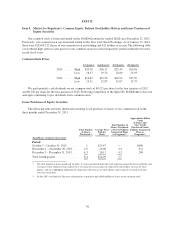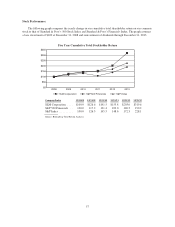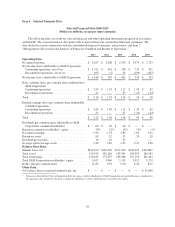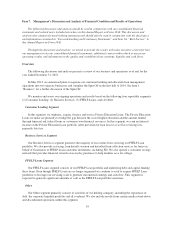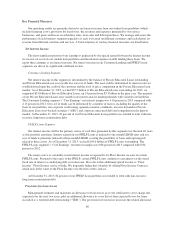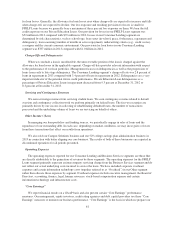Sallie Mae 2013 Annual Report Download - page 53
Download and view the complete annual report
Please find page 53 of the 2013 Sallie Mae annual report below. You can navigate through the pages in the report by either clicking on the pages listed below, or by using the keyword search tool below to find specific information within the annual report.recommendations, including reconsideration by Congress of the federal Bankruptcy Code’s treatment of Private
Education Loans and subjecting additional credit products to the disclosure and consumer protection framework
applicable to Private Education Loans. The CFPB’s 2013 Report recommended Congress consider making
reforms to the disclosures and guidelines that apply to payment application, records retention and other aspects of
student loan servicing to mirror changes previously made for the credit card and mortgage businesses. In the
future, Congress or the Administration may act on these recommendations or choose to take actions beyond or
unrelated to the CFPB’s recommendations to further regulate the Private Education Loan market or dictate the
terms and conditions applicable to Private Education Loans. Additionally, even in the absence of Congress or the
Administration pursuing the CFPB’s recommendations, the CFPB may use its regulatory authority and
enforcement actions to make substantial changes on its own to the Private Education Loan market and we believe
that the CFPB has shown through its actions that it is willing to do so. The taking of any such actions may
adversely impact the profitability and growth of our business and/or significantly alter the costs and manner in
which we choose to conduct this business.
In addition, the Dodd-Frank Act contains comprehensive provisions that govern the practices and oversight
of financial institutions (including large non-bank financial institutions) and other participants in the financial
markets. It imposes significant regulations on almost every aspect of the U.S. financial services industry,
including enhanced supervisory authority over our business. Many of the Dodd-Frank Act’s provisions have
become effective but remain subject to interpretation and formal implementation by regulatory authorities
through final rulemaking. As a result of the Dodd-Frank Act, the CFPB and other financial regulators have
introduced and continue to introduce new regulations and guidance, even as they impose enforcement actions
against financial institutions and financial service providers which often contain additional cautions and guidance
which must be taken into consideration. Due to the uncertainty engendered by these new regulations, guidance
and actions, coupled with the likelihood of additional changes or additions to the statutes, regulations and
practices applicable to our business, we are not able to estimate the ultimate impact of changes in law on its
financial results, business operations or strategies. We believe that the cost of responding to and complying with
these evolving laws and regulations, as well as any guidance from enforcement actions, will continue to increase,
as will the risk of penalties and fines from any enforcement actions that may be imposed on its businesses. Our
profitability, results of operations, financial condition, cash flows or future business prospects could be
materially and adversely affected as a result.
The Dodd-Frank Act authorizes state officials to enforce regulations issued by the CFPB and to enforce the
Dodd- Frank Act’s general prohibition against unfair, deceptive or abusive practices. Most states also have
statutes that prohibit unfair and deceptive practices. To the extent states enact requirements that differ from
federal standards or state officials and courts adopt interpretations of federal consumer laws that differ from those
adopted by the CFPB under the Dodd-Frank Act, or states increase their examination, supervision and
enforcement activities, our compliance costs could increase and reduce our ability to offer the same products and
services to consumers nationwide and we may be subject to a higher risk of state enforcement actions.
The FSOC could designate us as a systemically important non-bank financial company to be supervised by the
FRB. Designation as a so-called “SIFI” would impose significant additional statutorily–defined monitoring
and compliance regimes on our business and could significantly increase the levels of risk-based capital and
highly liquid assets we are required to hold. Required implementation of some or all of the measures currently
proposed by the FRB to be applicable to SIFIs would have a material impact on our business, results of
operations and financial condition.
As directed by the Dodd-Frank Act, on April 3, 2012, FSOC approved the final rule and interpretive
guidance regarding the designation of non-bank financial companies as SIFIs (the “SIFI Rules”). If designated as
a SIFI, a non-bank financial company will be supervised by the FRB and be subject to enhanced prudential
supervision and regulatory standards. While the separation of our businesses will reduce the complexity of both
organizations and may reduce our risk of designation as a SIFI under the SIFI Rules, no assurance can be given
that such a designation will not occur.
51




